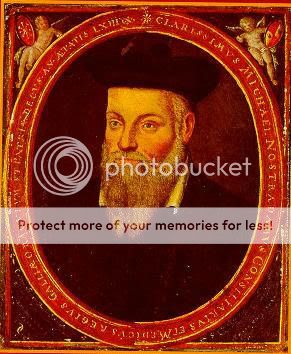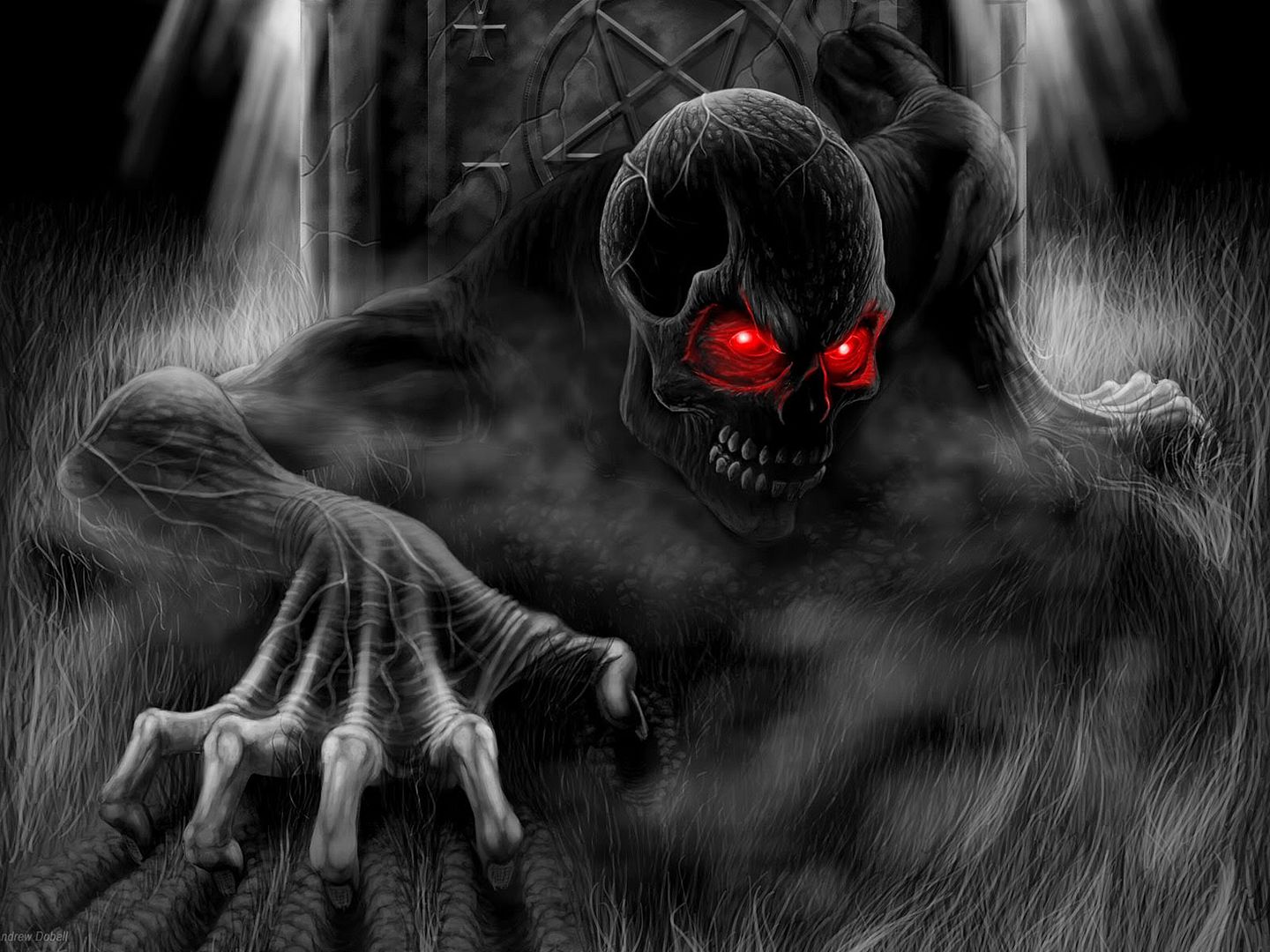
Friday, November 13, 2009
Thursday, November 12, 2009
Michel de Nostredame (14 December or 21 December 1503 – 2 July 1566), usually Latinised to Nostradamus, was a French apothecary and reputed seer who published collections of prophecies that have since become famous worldwide. He is best known for his book Les Propheties ("The Prophecies"), the first edition of which appeared in 1555. Since the publication of this book, which has rarely been out of print since his death, Nostradamus has attracted a following that, along with the popular press, credits him with predicting many major world events. The prophecies have in some cases been assimilated to the results of applying the alleged Bible code, as well as to other purported prophetic works.
Most academic sources maintain that the associations made between world events and Nostradamus's quatrains are largely the result of misinterpretations or mistranslations (sometimes deliberate) or else are so tenuous as to render them useless as evidence of any genuine predictive power. Moreover, none of the sources listed offers any evidence that anyone has ever interpreted any of Nostradamus's quatrains specifically enough to allow a clear identification of any event in advance.

Born on 14 or 21 December 1503 in Saint-Rémy-de-Provence in the south of France, where his claimed birthplace still exists, Michel de Nostredame was one of at least nine children of Reynière de St-Rémy and grain dealer and notary Jaume de Nostredame. The latter's family had originally been Jewish, but Jaume's father, Guy Gassonet, had converted to Catholicism around 1455, taking the Christian name "Pierre" and the surname "Nostredame" (the latter apparently from the saint's day on which his conversion was solemnized). Michel's known siblings included Delphine, Jehan (c. 1507–77), Pierre, Hector, Louis, Bertrand, Jean II (born 1522) and Antoine (born 1523). Little else is known about his childhood, although there is a persistent tradition that he was educated by his maternal great-grandfather Jean de St. Rémy – a tradition which is somewhat vitiated by the fact that the latter disappears from the historical record after 1504, when the child was only one year old.
In 1531 Nostredame was invited by Jules-César Scaliger, a leading Renaissance scholar, to come to Agen. There he married a woman of uncertain name (possibly Henriette d'Encausse), who bore him two children. In 1534 his wife and children died, presumably from the Plague. After their deaths, he continued to travel, passing through France and possibly Italy.
On his return in 1545, he assisted the prominent physician Louis Serre in his fight against a major plague outbreak in Marseille, and then tackled further outbreaks of disease on his own in Salon-de-Provence and in the regional capital, Aix-en-Provence. Finally, in 1547, he settled in Salon-de-Provence in the house which exists today, where he married a rich widow named Anne Ponsarde, with whom he had six children – three daughters and three sons. Between 1556 and 1567 he and his wife acquired a one-thirteenth share in a huge canal project organized by Adam de Craponne to irrigate largely waterless Salon-de-Provence and the nearby Désert de la Crau from the river Durance.
After another visit to Italy, Nostredame began to move away from medicine and toward the occult. Following popular trends, he wrote an almanac for 1550, for the first time Latinizing his name from Nostredame to Nostradamus. He was so encouraged by the almanac's success that he decided to write one or more annually. Taken together, they are known to have contained at least 6,338 prophecies,[2][10] as well as at least eleven annual calendars, all of them starting on 1 January and not, as is sometimes supposed, in March. It was mainly in response to the almanacs that the nobility and other prominent persons from far away soon started asking for horoscopes and "psychic" advice from him, though he generally expected his clients to supply the birth charts on which these would be based, rather than calculating them himself as a professional astrologer would have done. When obliged to attempt this himself on the basis of the published tables of the day, he always made numerous errors, and never adjusted the figures for his clients' place or time of birth. (Refer to the analysis of these charts by Brind'Amour, 1993, and compare Gruber's comprehensive critique of Nostradamus’ horoscope for Crown Prince Rudolph Maximilian.)
He then began his project of writing a book of one thousand mainly French quatrains, which constitute the largely undated prophecies for which he is most famous today. Feeling vulnerable to religious fanatics, however, he devised a method of obscuring his meaning by using "Virgilianized" syntax, word games and a mixture of other languages such as Greek, Italian, Latin, and Provençal. For technical reasons connected with their publication in three installments (the publisher of the third and last installment seems to have been unwilling to start it in the middle of a "Century," or book of 100 verses), the last fifty-eight quatrains of the seventh "Century" have not survived into any extant edition.
The quatrains, published in a book titled Les Propheties (The Prophecies), received a mixed reaction when they were published. Some people thought Nostradamus was a servant of evil, a fake, or insane, while many of the elite thought his quatrains were spiritually inspired prophecies – as, in the light of their post-Biblical sources (see under Nostradamus's sources below), Nostradamus himself was indeed prone to claim. Catherine de Médicis, the queen consort of King Henri II of France, was one of Nostradamus's greatest admirers. After reading his almanacs for 1555, which hinted at unnamed threats to the royal family, she summoned him to Paris to explain them and to draw up horoscopes for her children. At the time, he feared that he would be beheaded,[13] but by the time of his death in 1566, Catherine had made him Counselor and Physician-in-Ordinary to the King.
Some accounts of Nostradamus's life state that he was afraid of being persecuted for heresy by the Inquisition, but neither prophecy nor astrology fell in this bracket, and he would have been in danger only if he had practiced magic to support them. In fact, his relationship with the Church as a prophet and healer was excellent. His brief imprisonment at Marignane in late 1561 came about purely because he had published his 1562 almanac without the prior permission of a bishop, contrary to a recent royal decreeIn The Prophecies he compiled his collection of major, long-term predictions. The first installment was published in 1555. The second, with 289 further prophetic verses, was printed in 1557. The third edition, with three hundred new quatrains, was reportedly printed in 1558, but now only survives as part of the omnibus edition that was published after his death in 1568. This version contains one unrhymed and 941 rhymed quatrains, grouped into nine sets of 100 and one of 42, called "Centuries".
Given printing practices at the time (which included type-setting from dictation), no two editions turned out to be identical, and it is relatively rare to find even two copies that are exactly the same. Certainly there is no warrant for assuming – as would-be "code-breakers" are prone to do – that either the spellings or the punctuation of any edition are Nostradamus' originals.
The Almanacs. By far the most popular of his works, these were published annually from 1550 until his death. He often published two or three in a year, entitled either Almanachs (detailed predictions), Prognostications or Presages (more generalized predictions).
Nostradamus was not only a diviner, but a professional healer, too. It is known that he wrote at least two books on medical science. One was an extremely free translation (i.e. a "paraphrase") of The Protreptic of Galen (Paraphrase de C. GALIEN, sus l'Exhortation de Menodote aux estudes des bonnes Artz, mesmement Medicine) , and in his so-called Traité des fardemens (basically a medical cookbook containing, once again, materials borrowed mainly from others) he included a description of the methods he used to treat the plague – none of which, not even the bloodletting, apparently worked. The same book also describes the preparation of cosmetics.
A manuscript normally known as the Orus Apollo also exists in the Lyon municipal library, where upwards of 2,000 original documents relating to Nostradamus are stored under the aegis of Michel Chomarat. It is a purported translation of an ancient Greek work on Egyptian hieroglyphs based on later Latin versions, all of them unfortunately ignorant of the true meanings of the ancient Egyptian script, which was not correctly deciphered until the advent of Champollion in the 19th century.
Since his death only the Prophecies have continued to be popular, but in this case they have been quite extraordinarily so. Over two hundred editions of them have appeared in that time, together with over 2000 commentaries. Their popularity seems to be partly due to the fact that their vagueness and lack of dating make it easy to quote them selectively after every major dramatic event and retrospectively claim them as "hits"




